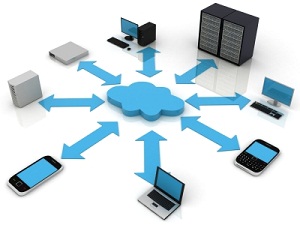Cloud computing has a lot of hype surrounding it. More than a few observers have wondered what is so important about this new internet phenomenon. The truth is cloud computing is leading to a rethinking of the internet’s capability. Cloud computing promises to completely delocalise computing power and technology. Users will be able to access and manipulate files, images, videos and other data remotely. Cloud computing promises the ability to keep networks and mobile devices synchronised at all times.
Infrastructure
A bank of sophisticated computers host operating systems and data for hundreds, if not thousands, of customers. internet search engine giant Google pioneered the use of data centers to store clients’ personal data safely. The same principle is being extended to cloud computing. Huge data centers will act as remote desktop computers. These centers will be able to store every file a user would need. All the user needs is a counterpart machine that can be as small as a conventional laptop with much less weight. These so-called “netbooks” serve only to connect the user to the internet so he can access his files.

An example of how cloud computing works – every device synchronises with the cloud, meaning that your data can be accessed anywhere!
A single data center can offer multiple services and applications. Theoretically, a cloud computing system could perform almost any function or task the user desires. In a typical system, each application will have its own dedicated server combined with multiple iterations to create redundancy and prevent sudden malfunctions. The whole center is managed by a central server that constantly monitors the traffic and load volumes. Balancing the differences between machines, it seeks to maintain the harmony of the system and prevent crashes.
Business Advantages
The advent of cloud computing is actually forcing businesses to change their strategies. Previously, hiring a new employee meant providing him with a desk, computer equipment and various other hardware or software. Cloud computing allows them to reduce these capital expenditures significantly. Now all an employee needs is a computer with an internet connection to access his work data. Desks and office equipment may still be necessary, but the investment in computer hardware can be outsourced to cloud computing companies.
The hardware and software demands on the business’s side decrease dramatically. Labor costs per individual employees go down, enabling a company to hire more workers. Productivity increases, raising the efficiency and profits of the business.
Concerns
The primary reason why cloud computing is getting so much attention is its effect on business strategies. The sheer cost pressure alone is forcing industry after industry to adapt to the new reality. The advantages notwithstanding, several valid concerns about cloud computing exist, namely having to do with privacy and security.
Business owners and executives may hesitate to turn over their sensitive data to a third-party system with good reason. Losing access to their own data or having it compromised is unacceptable in a ruthlessly competitive private sector. One major argument against this fear is the fact that cloud computing companies survive based on their reputations. This gives them a huge incentive not to lose their clients data or compromise accessibility. Despite the power of this incentive, regulations may still be required to ensure safety.
As for privacy, the obvious concern is the connection between the user’s computer and the cloud system. Privacy could easily be compromised by unscrupulous individuals who could access personal information like credit card numbers. A solution to this problem is to use authentication and encryption like regular secure connections.
These practical concerns are somewhat overshadowed by a number of philosophical and legal questions. For instance, who owns the data stored by the cloud computing system? While it is held in the client’s name, a case could conceivably be made that the cloud computing system is the actual owner and therefore has a right to it. These technicalities are still under debate, and no resolution has yet been achieved.
Conclusion
Cloud computing holds great promise for upending things as they are currently done in the business world. The practical effects on information technology jobs will likely be profound. These and other challenges must be met because cloud computing will continue to change the nature of the internet.
